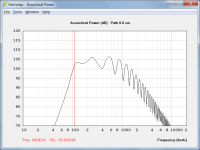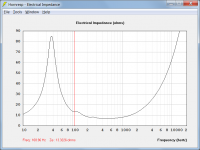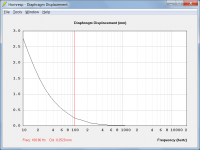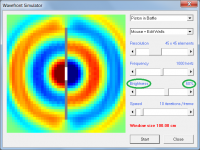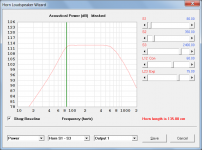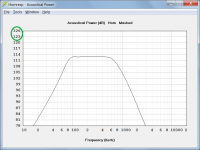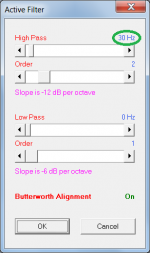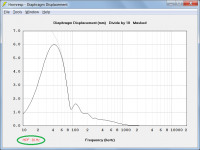"Electroacoustics -The Analysis of Transduction and Its Historical Background" Autho
I have not found a free PDF of it on the web to reference here.
Just an abstract of what's between the covers.
I purchased my copy from the ASA when my membership was active.
WHG
Just gives you an introduction.
Not the meat of the text book.
I have not found a free PDF of it on the web to reference here.
Just an abstract of what's between the covers.
I purchased my copy from the ASA when my membership was active.
WHG
I have been looking through my text books as well.
Most of the comments up to date are correct.
But.
I'm not sure that every possible enclosure that can be modeled in Hornresp behaves in the same manner.
Closed and vented boxes are a no brainer.
Horns pretty easy.
Open baffle are again the peak in the electrical impedance.
Band pass Fb ( not the correct nomenclature for a band pass) will be similar to a vented box.
Compound horn should have a defined low frequency peak in impedance.
Something just is still making me search.
I think this is correct. Just not absolutely positive.
Most of the comments up to date are correct.
But.
I'm not sure that every possible enclosure that can be modeled in Hornresp behaves in the same manner.
Closed and vented boxes are a no brainer.
Horns pretty easy.
Open baffle are again the peak in the electrical impedance.
Band pass Fb ( not the correct nomenclature for a band pass) will be similar to a vented box.
Compound horn should have a defined low frequency peak in impedance.
Something just is still making me search.
I think this is correct. Just not absolutely positive.
I'm not sure that every possible enclosure that can be modeled in Hornresp behaves in the same manner.
The only ones that are of concern to me wrt my suggestion is those at don't provide any damping for the driver below the last resonance frequency, i.e. any alignment that does not involve a sealed chamber either directly behind or in front of the driver.
The more I think about this the more I'm concluding it's a brain fart on my part.
I think almost every possibility has been covered.
An open baffle setup for example is simply the highest point in the electrical impedance.
And looking as much as I can in quite a few tests books I am not finding anything to different than what most of the comments are saying.
I think it is pretty much covered.
I think almost every possibility has been covered.
An open baffle setup for example is simply the highest point in the electrical impedance.
And looking as much as I can in quite a few tests books I am not finding anything to different than what most of the comments are saying.
I think it is pretty much covered.
Resonance Frequency
Hi Everyone,
Thanks for your feedback.
My original plan was to test for the option #2 condition, but also to identify those cases in which the option #1 test should be applied instead. In light of your comments I will continue along those lines. The algorithm I intend using is relatively simple and fast, but seems to be remarkably resilient. It appears to give valid results for all the system configurations I have tested so far.
Incidentally, the reason I settled on testing electrical impedance is because in the more marginal cases it is easier to identify the resonance dip in the impedance curve than in the diaphragm displacement curve, as illustrated in the attached example. The algorithm can detect the slight resonance "dip" at 108.96 hertz in the impedance curve, but there is no such dip to be identified anywhere in the displacement curve. Also, the effect of the voice coil inductance can be masked when testing using the impedance curve, making it easier to identify resonance frequencies in the more "difficult" systems. In such cases, the displacement curve does not give any indication as to the position of the resonance frequency.
By definition, the resonance frequency is the frequency at which the imaginary or reactive part of the input impedance becomes zero. It is interesting to note that for some loudspeaker systems the frequency of interest is at an impedance maximum (similar to a parallel RLC resonant circuit) and for other systems it is at an impedance minimum (similar to a series RLC resonant circuit). In each case however, the reactive component of impedance at the frequency of interest is zero, consistent with the definition of resonance frequency.
In Hornresp I will refer to the "principal resonance frequency" rather than to the "lowest resonance frequency". Given the circumstances, I believe that it is a more accurate description.
Kind regards,
David
Hi Everyone,
Thanks for your feedback.
My original plan was to test for the option #2 condition, but also to identify those cases in which the option #1 test should be applied instead. In light of your comments I will continue along those lines. The algorithm I intend using is relatively simple and fast, but seems to be remarkably resilient. It appears to give valid results for all the system configurations I have tested so far.
Incidentally, the reason I settled on testing electrical impedance is because in the more marginal cases it is easier to identify the resonance dip in the impedance curve than in the diaphragm displacement curve, as illustrated in the attached example. The algorithm can detect the slight resonance "dip" at 108.96 hertz in the impedance curve, but there is no such dip to be identified anywhere in the displacement curve. Also, the effect of the voice coil inductance can be masked when testing using the impedance curve, making it easier to identify resonance frequencies in the more "difficult" systems. In such cases, the displacement curve does not give any indication as to the position of the resonance frequency.
By definition, the resonance frequency is the frequency at which the imaginary or reactive part of the input impedance becomes zero. It is interesting to note that for some loudspeaker systems the frequency of interest is at an impedance maximum (similar to a parallel RLC resonant circuit) and for other systems it is at an impedance minimum (similar to a series RLC resonant circuit). In each case however, the reactive component of impedance at the frequency of interest is zero, consistent with the definition of resonance frequency.
In Hornresp I will refer to the "principal resonance frequency" rather than to the "lowest resonance frequency". Given the circumstances, I believe that it is a more accurate description.
Kind regards,
David
Attachments
Don't know whether this was asked before or not... I'll just give a try!
Have you ever considered making Hornresp Open Source?
I think the hole "project" would only benefit from it.
Just think about things like porting it to another language (i.e C++), a GUI looking way more... "Modern" (Qt or so), GPGPU/improved Multicore Processing, maybe better import tools (WinISD TSPs, etc.)...
And you could still forbid commercial use without license...
Kind regards,
Robin
Have you ever considered making Hornresp Open Source?
I think the hole "project" would only benefit from it.
Just think about things like porting it to another language (i.e C++), a GUI looking way more... "Modern" (Qt or so), GPGPU/improved Multicore Processing, maybe better import tools (WinISD TSPs, etc.)...
And you could still forbid commercial use without license...
Kind regards,
Robin
Hornresp Update 3960-160201
Hi Everyone,
CHANGE 1
Some minor changes have been made to the recently enhanced Wavefront Simulator.
In the previous release the "Brightness" slider was renamed as the "Level" slider. The slider caption has now been changed back to "Brightness", with the brightness value being given as a percentage. On reflection I decided that "Brightness" was a more meaningful description than "Level". See Attachment 1.
Previously it was possible to select "Add Baffle" when using the Custom Design option. This is no longer the case, since it was not applicable anyway.
Some other minor cosmetic refinements have also been made.
CHANGE 2
Requested by Brian in Post #5931.
A marker (vertical green line) indicating the principal resonance frequency can now be added to the Loudspeaker Wizard Power chart by double-clicking anywhere on the chart. The marker can be removed by pressing the Esc key. See Attachment 2.
CHANGE 3
Requested by Brian in Post #5931.
The SPL scale on all Power charts can now be changed from the default 5 dB increments to either 3 dB or 6 dB increments by double-clicking anywhere on the chart Y-axis vertical scale. See Attachment 3.
CHANGE 4
Requested by just a guy in Post #5954.
A high pass, low pass or band pass active filter can now be specified prior to calculating the main results. Select the Tools > Filter menu option from the Input Parameters window. The filter is not applicable when Eg is set to zero, or when Maximum SPL has been calculated. See Attachments 4 and 5.
Kind regards,
David
Hi Everyone,
CHANGE 1
Some minor changes have been made to the recently enhanced Wavefront Simulator.
In the previous release the "Brightness" slider was renamed as the "Level" slider. The slider caption has now been changed back to "Brightness", with the brightness value being given as a percentage. On reflection I decided that "Brightness" was a more meaningful description than "Level". See Attachment 1.
Previously it was possible to select "Add Baffle" when using the Custom Design option. This is no longer the case, since it was not applicable anyway.
Some other minor cosmetic refinements have also been made.
CHANGE 2
Requested by Brian in Post #5931.
A marker (vertical green line) indicating the principal resonance frequency can now be added to the Loudspeaker Wizard Power chart by double-clicking anywhere on the chart. The marker can be removed by pressing the Esc key. See Attachment 2.
CHANGE 3
Requested by Brian in Post #5931.
The SPL scale on all Power charts can now be changed from the default 5 dB increments to either 3 dB or 6 dB increments by double-clicking anywhere on the chart Y-axis vertical scale. See Attachment 3.
CHANGE 4
Requested by just a guy in Post #5954.
A high pass, low pass or band pass active filter can now be specified prior to calculating the main results. Select the Tools > Filter menu option from the Input Parameters window. The filter is not applicable when Eg is set to zero, or when Maximum SPL has been calculated. See Attachments 4 and 5.
Kind regards,
David
Attachments
Have you ever considered making Hornresp Open Source?
Hi Robin,
I have been asked a number of times via email if I would release the Hornresp source code (including in some cases by private companies). Hornresp is one of my long-time hobbies, and a very enjoyable one at that. If I were to release the code, the pleasure I currently gain from working on Hornresp would be significantly diminished.
Hornresp is all my own work - after more than forty years of working on the program in one form or another, I would really like to keep it that way
Kind regards,
David
Thanks very much, this will be very useful.
Thanks for the thanks
Hornresp is all my own work - after more than forty years of working on the program in one form or another, I would really like to keep it that way
A few thoughts on this... From what I understand, David has stretched the basic framework of Hornresp to the limit and then some. And I get the impression that navigating the code has become a rather large task in itself
IMO, an Open Source version of Hornresp should start out as an Open Source project. Most of the code is handling of the user interface anyway, and changing the UI means rewriting most of the code. Which means that the original Hornresp source code is not the best starting point if a new UI is what you want. It is probably better to start from scratch.
CHANGE 2
Requested by Brian in Post #5931.
A marker (vertical green line) indicating the principal resonance frequency can now be added to the Loudspeaker Wizard Power chart by double-clicking anywhere on the chart. The marker can be removed by pressing the Esc key. See Attachment 2.
CHANGE 3
Requested by Brian in Post #5931.
The SPL scale on all Power charts can now be changed from the default 5 dB increments to either 3 dB or 6 dB increments by double-clicking anywhere on the chart Y-axis vertical scale. See Attachment 3.
Excellent, thanks!
Hi Kees,
Hornresp has no way of knowing how many ports there are, so you need to specify the total area.
For the example you give, if Ap is shown in Hornresp as 113 cm2 and you intend having four ports, then you are assuming that each of those ports has a cross-sectional area of 28.25 cm2 and a diameter of 6 cm.
Kind regards,
David
Thanks david, I already thought so, but for shure, ask the master.
thanks
Hi Bjørn,
You understand correctly .
.
The code structures controlling the user interface are now so complex that I keep getting lost in them myself, particularly when I need to re-visit parts of the program that haven't been touched in ages. I suspect that anyone looking at the Hornresp source code would have difficulty making much sense of it - for starters, there are just so many different status flags to contend with.
One of the reasons for the complexity is that many of the controls now have multiple functions - a result of squeezing as much as possible out of what is really a relatively limited set of inputs. Also, the program has just grown and grown over the years, with features being added on randomly as requested by users. The fundamental architecture has not been re-built along the way to better accommodate these additions, however.
If you are aware of a problem could you please provide some details so that I can try to fix it .
.
As advised some time ago, I have a "zero-tolerance" policy when it comes to bugs in Hornresp. "Nearly 100% bug-free" is just not good enough!
Kind regards,
David
From what I understand, David has stretched the basic framework of Hornresp to the limit and then some. And I get the impression that navigating the code has become a rather large task in itself
You understand correctly
The code structures controlling the user interface are now so complex that I keep getting lost in them myself, particularly when I need to re-visit parts of the program that haven't been touched in ages. I suspect that anyone looking at the Hornresp source code would have difficulty making much sense of it - for starters, there are just so many different status flags to contend with.
One of the reasons for the complexity is that many of the controls now have multiple functions - a result of squeezing as much as possible out of what is really a relatively limited set of inputs. Also, the program has just grown and grown over the years, with features being added on randomly as requested by users. The fundamental architecture has not been re-built along the way to better accommodate these additions, however.
Hornresp is nearly 100% bug-free
If you are aware of a problem could you please provide some details so that I can try to fix it
As advised some time ago, I have a "zero-tolerance" policy when it comes to bugs in Hornresp. "Nearly 100% bug-free" is just not good enough!
Kind regards,
David
If you are aware of a problem could you please provide some details so that I can try to fix it.
As advised some time ago, I have a "zero-tolerance" policy when it comes to bugs in Hornresp. "Nearly 100% bug-free" is just not good enough!
Sorry David, I should of course have said "100% bug-free, as far as I'm aware"
Do what ?! 
Hmm, assuming you're referring to the 'edit' button, it's only active in the 'editor' mode, like when going to the 'previous' or 'next' 'record', otherwise you just change whatever field you want to change, then you can choose to save it or not when clicking 'add', 'previous' or 'delete' the 'record'.
GM

Hmm, assuming you're referring to the 'edit' button, it's only active in the 'editor' mode, like when going to the 'previous' or 'next' 'record', otherwise you just change whatever field
GM
- Home
- Loudspeakers
- Subwoofers
- Hornresp
